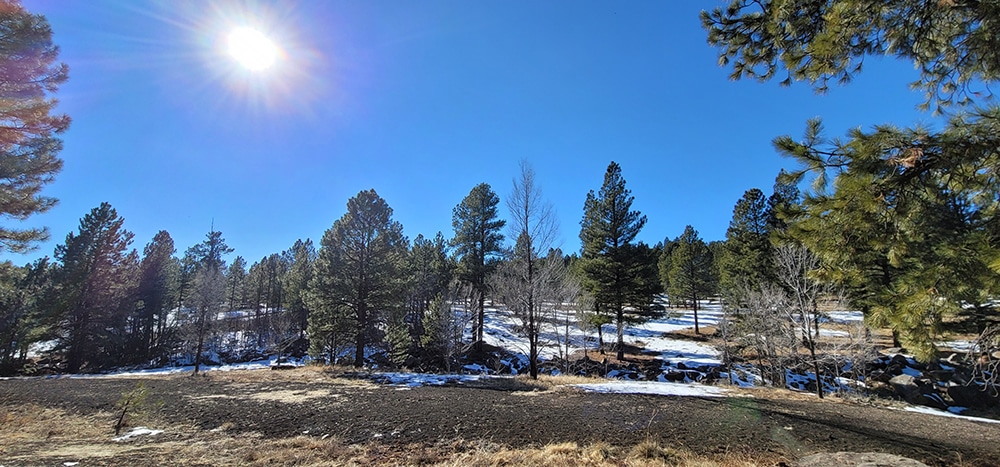*Editor’s Note: The “Views from NAU” blog series highlights the thoughts of different people affiliated with NAU, including faculty members sharing opinions or research in their areas of expertise. The views expressed reflect the authors’ own personal perspectives.
 By Nicole Walker
By Nicole Walker
Professor, Department of English
Dr. Walker is a professor of creative nonfiction writing who has written dozens of articles and essays for both academic and literary journals and maintain steam publications like The New York Times. Her writing focuses heavily on sustainability but also includes essays on relationships, self-reflection, the acting of writing and more. She is the author of several books, including Sustainability: A Love Story, Processed Meats, This Noisy Egg, Where the Tiny Things Are, Micrograms, Bending Genre, Quench Your Thirst With Salt and others.
We Flagstaff and NAU inhabitants live among the world’s largest contiguous ponderosa pine forests. The ponderosas bear extreme climates–very cold and very snowy and awfully hot and pretty dry. They grow so tall so slowly that you might miss their abundant accumulations in both height and thickness. In the winter, it sometimes (at least this year!) snows in this ponderosa pine forest 150 inches a year. The snow collects in layers like the Kaibab, Coconino, Navajo sandstones collected in the canyons over the last 100 million to 300 million years. But unlike that long-lived stone, the snow turns over, year by year. It falls in chunks. It melts before the branches break. Seventy-five mile-an-hour winds bend the trees over, their branches touching ground, like an excellent yogi, flinging snow like catapults.
And then it doesn’t rain for six months.

And then it rains, thanks to monsoon storms which arrive, usually, in July, pouring water into the dirt and the aquifer as a promise that we’ll make it through no-rain fall to the next snows. In the fall, they lose dry, orange needles, sinking nitrogen and carbon back into the ground to feed themselves later. Trees never draw lines in the sand to signal a singular future. They say, “I am subject to a lot of different lines: fire lines, chains of saws, marching troops of beetles crawling up, two-by-two, up and into my bark. I am vulnerable, but I can take it. If given enough time.” Is it “we” instead of “I” that makes the trees particularly resilient? Trees adapted by knowing there is more than one way to reach the sky.
In September 2016, a German forester named Peter Wohlleben wrote a book called The Hidden Life of Trees. I loved to think about how trees may be smarter than me. Wohlleben’s work shows how trees communicate, feel and work in social networks. Wohlleben’s work isn’t universally beloved. He’s been castigated for anthropomorphizing, playing fast and loose with terminology and having an agenda.
Sentimentalizing is another kind of anthropomorphizing. I tell my students we can’t know what it’s like to be a dog or a cougar or a tree, and it’s hubristic to try to pretend. But what I love about Wohlleben’s idea is the way he sees trees looking out for each other. To me, that’s not quite anthropomorphizing. The mycelia and hyphae that form an underground nexus for communication can, for example, pull nutrients from a well-satiated tree to give to one that’s struggling. Some people do this for other humans. Some governments try to. But charity is different from automatic, somatic sharing. It’s not anthropomorphizing if the trees do it better than the anthros. Perhaps in discussing altruism, it’s assigning tree-like actions to humans that’s the upside-down part.

Ken Coder, a forester with the University of Georgia, found evidence that trees have deeper complexity in their genome than humans. The black mulberry has 308 chromosomes in 11 complete sets compared to homo sapiens’ single set of 46 chromosomes. Coder argues that trees have more chromosomes because they are stuck in place. They have to find ways to adapt from their stationary positions. Humans can run, freeze or fight, which means they can adapt with their feet–their evolutionary success includes speed. What if you, like a tree, had to stay with the trouble, take your time, and your descendants, to figure out how to respond to this particular threat, that particular change in the climate?
What I like most about forest research is discovering how things work at the microscopic level. Underneath the piles of rotting needles and leaves, slug trails, fallen trees and soil are thin threads of mycelia that make up the carpet of mycorrhizal fungi, which undergirds so much of the living forest. This rangy, webby underlayment pushes up mushrooms to reproduce, but its most magnificent job is pushing nutrients into the hyphae–tiny hairs that reach out from the mycelia into the roots of trees. These fungal threads can be very fine, branching between soil particles and even exploring the shells of dead insects. The mycelia send nutrients up to the leaves of the tree. The trees, doing their own photosynthetic magic, send different nutrients back down to the mycelia. This microscopic push-and-pull is the kind of synergy I wish I had, that we all had, among our families and communities. When one nutrient is lacking, the entire forest works together to provide, to connect the roots of the forest together. If I can make a clumsy metaphor here, which is mainly how I do it, it is this stuff of the sky light, energy, the ethereal things that are converted into bodily substance and the body, in this case, the body of a tree, pushing substance back into light. Earth Day celebrates the resilience of the Earth—although maybe we should give Earth a bit of a break, a little time to bounce.




 By Nicole Walker
By Nicole Walker